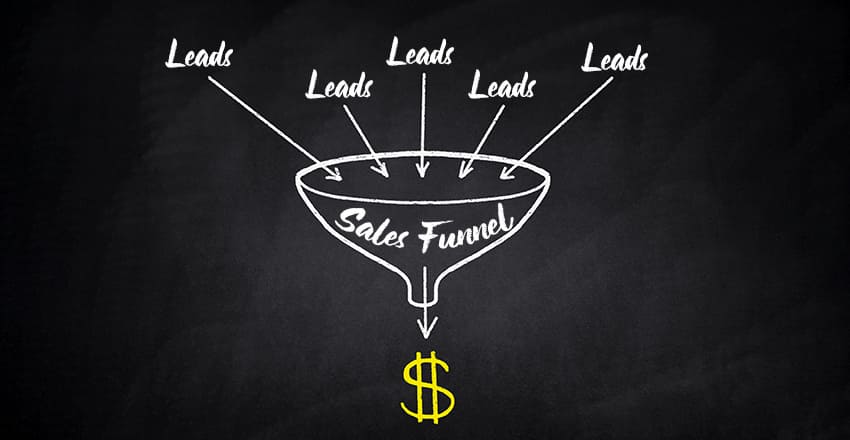- By Javeria
- January 10, 2024

As an entrepreneur, you need to understand the importance of marketing. Without marketing, your business would ultimately go down. If you haven’t already put time and effort into streamlining your marketing, now is the time to start. A good starting point is by employing a sales funnel.
A sales funnel is an essential tool that can help you figure out where and how to improve your sales process. Improving the sales funnel should be one of your top priorities if you are to increase sales performance. A great sales funnel gives salespeople insight into their potential buyer’s thought processes, decisions, and challenges.
In spite of the fact that a sales funnel holds grave importance for organizations in this day and age, nearly 68% of businesses have not identified or tried to measure a sales funnel. Another statistic indicates that 79% of marketing leads are never converted into paying customers, which is predominantly due to the absence of a sales funnel.
A sales funnel is a marketing concept that describes the path your prospect should take in order to purchase a product or service. It consists of three parts:
Attracting people to your brand (e.g. by advertising your physical shop or the landing page of your site to capture leads).
Including all the parts of your sales process prior to the sale (e.g. people trying on products in your store or website visitors reading about the benefits of your products/services).
Closing a sale and nurturing customers post-purchase (e.g. customers paying for products at checkout or providing upgrade offers to loyal customers).
Prospects usually undergo 4 stages in the sales funnel, where they learn about your product or service and decide whether or not they want to purchase it. These stages represent the mindset of the buyer. It is easy to remember these stages by using the acronym AIDA.
This is the moment when you catch the customer’s attention for the first time. You can do so by promoting your business through a variety of paid and organic means. The idea is to get the user to visit your website, so they can learn in detail about your product/service and what you offer.
Research and inquiry placement are indicators that the consumer has an interest in your product/service. You can attract such a person with some great content, but make sure you don’t sound too pushy. Their decision is not made yet and selling your products to them at this stage may force them to leave.
At this stage, the prospect decides that he/she is ready to buy and wants to take advantage of your offering. They pay more attention to what you offer and compare it to others. Pricing, packages, and other factors are tallied with your competitors in this stage so the best option can be identified.
By taking an action, which is usually in the form of a purchase, the prospect becomes your customer. Even though the sale is complete in this phase, the sales process never ends. Your goal is to focus on customer retention so the customer makes future purchases. Keep sending useful content and attractive offers to customers to build loyalty. For example, after making a sale, you can thank the customer for the purchase, ask them to give feedback, invite them to sign up on your channel, or enroll them in a rewards program.
Knowing your target audience is the starting point of the sales funnel. At this stage, the more relevant people you can reach out to, the more customers you can build. Base your research on the following points:
A landing page is the first place a customer gets to know about your company and is also a significant point for many marketing campaigns. It’s the page where people land once they click on an ad, a social media post, or if they sign up for an account. To make a landing page, you’ll need the following:
One of the well-known rules of online marketing success is to give as much as you can before expecting something in return from your users. Your audience’s interest heightens when you give them discounts or free downloadable content of value like white papers, free videos, a checklist, and other informational material about your product and services.
It is important to add lead magnets to your landing page to generate interest in your product and to stay in touch with your audience. You can make an email list that allows you to contact people directly. As you send newsletters to leads, you can also nurture them and keep your brand at the top of their minds.
If people are not aware of your brand, there will be no sales. Therefore, you need to implement different strategies to drive users to your website. You can adopt the following measures for this purpose:
Your efforts will bear no fruit if you are unable to engage your audience. They need to learn about your product and services, and this goal can be attained with the help of the following tactics:
The final stage is where visitors convert into paying customers. Make sure that completing a purchase does not take too long. You can do so by:
If the visitor becomes a customer, continue to build the relationship by giving information about your products or services, engaging them regularly, and offering great service to retain them. If the user does not make a purchase, stay in touch with them by using different nurturing emails.
Every business is looking to convert their visitors into leads and then turning their leads into customers. A sales funnel is the ideal solution for this purpose since it can help you track your leads as they progress closer to becoming paying customers. Creating a sales funnel is not too difficult. Just follow the steps we’ve indicated in this article and you should be good to go.